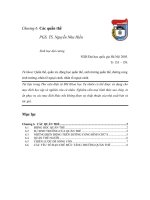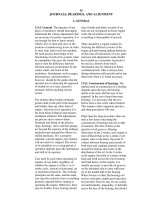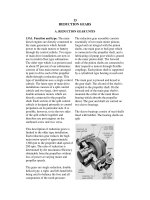Tài liệu Stepper Motor Controllers ppt
Bạn đang xem bản rút gọn của tài liệu. Xem và tải ngay bản đầy đủ của tài liệu tại đây (224.95 KB, 12 trang )
DatasheetArchive.com
Request For Quotation
Order the parts you need from our real-time inventory database.
Simply complete a request for quotation form with your part
information and a sales representative will respond to you with
price and availability.
Request For Quotation
Your free datasheet starts on the next page.
More datasheets and data books are available from our
homepage:
This datasheet has been downloaded from .
®
L297
STEPPER MOTOR CONTROLLERS
NORMAL/WAVE DRIVE
HALF/FULL STEP MODES
CLOCKWISE/ANTICLOCKWISE DIRECTION
SWITCHMODE LOAD CURRENT REGULA-
TION
PROGRAMMABLE LOAD CURRENT
FEW EXTERNAL COMPONENTS
RESET INPUT & HOME OUTPUT
ENABLE INPUT
DESCRIPTION
The L297 Stepper Motor Controller IC generates
four phase drive signals for two phase bipolar and
four phase unipolar step motors in microcomputer-
controlled applications. The motor can be driven in
half step, normal and wawe drive modes and on-
chip PWM chopper circuits permit switch-mode
control of the current in the windings. A feature of
December 2001
Symbol Parameter Value Unit
V
s
Supply voltage 10 V
V
i
Input signals 7V
P
tot
Total power dissipation (T
amb
= 70
°
C)
1W
T
stg
, T
j
Storage and junction temperature -40 to + 150
°
C
ABSOLUTE MAXIMUM RATINGS
this device is that it requires only clock, direction
and mode input signals. Since the phase are gen-
erated internally the burden on the microprocessor,
and the programmer, is greatly reduced. Mounted
in DIP20 and SO20 packages, the L297 can be
used with monolithic bridge drives such as the
L298N or L293E, or with discrete transistors and
darlingtons.
TWO PHASE BIPOLAR STEPPER MOTOR CONTROL CIRCUIT
DIP20 SO20
ORDERING NUMBERS
: L297/1 (DIP20)
L297D (SO20)
1/11
PIN CONNECTION
(Top view)
BLOCK DIAGRAM
(L297/1 - L297D)
2/11
L297/1
L297D
L297
N
°
NAME FUNCTION
1 SYNC Output of the on-chip chopper oscillator.
The SYNC connections The SYNC connections of all L297s to be
synchronized are connected together and the oscillator
components are omitted on all but one. If an external clock source
is used it is injected at this terminal.
2 GND Ground connection.
3 HOME Open collector output that indicates when the L297 is in its initial
state (ABCD = 0101).
The transistor is open when this signal is active.
4 A Motor phase A drive signal for power stage.
5
INH1 Active low inhibit control for driver stage of A and B phases.
When a bipolar bridge is used this signal can be used to ensure
fast decay of load current when a winding is de-energized. Also
used by chopper to regulate load current if CONTROL input is low.
6 B Motor phase B drive signal for power stage.
7 C Motor phase C drive signal for power stage.
8
INH2 Active low inhibit control for drive stages of C and D phases.
Same functions as INH1.
9 D Motor phase D drive signal for power stage.
10 ENABLE Chip enable input. When low (inactive) INH1, INH2, A, B, C and D
are brought low.
11 CONTROL Control input that defines action of chopper.
When low chopper acts on INH1 and INH2; when high chopper
acts on phase lines ABCD.
12 V
s
5V supply input.
13 SENS
2
Input for load current sense voltage from power stages of phases
C and D.
14 SENS
1
Input for load current sense voltage from power stages of phases
A and B.
15 V
ref
Reference voltage for chopper circuit. A voltage applied to this pin
determines the peak load current.
16 OSC
An RC network (R to V
CC
, C to ground) connected to this terminal
determines the chopper rate. This terminal is connected to ground
on all but one device in synchronized multi - L297 configurations. f
≅
1/0.69 RC
17 CW/
CCW Clockwise/counterclockwise direction control input.
Physical direction of motor rotation also depends on connection
of windings.
Synchronized internally therefore direction can be changed at any
time.
18
CLOCK Step clock. An active low pulse on this input advances the motor
one increment. The step occurs on the rising edge of this signal.
PIN FUNCTIONS - L297/1 - L297D
3/11
L297
N
°
NAME FUNCTION
19 HALF/
FULL Half/full step select input. When high selects half step operation,
when low selects full step operation. One-phase-on full step mode
is obtained by selecting FULL when the L297’s translator is at an
even-numbered state.
Two-phase-on full step mode is set by selecting FULL when the
translator is at an odd numbered position. (The home position is
designate state 1).
20
RESET Reset input. An active low pulse on this input restores the
translator to the home position (state 1, ABCD = 0101).
PIN FUNCTIONS - L297/1 - L297D
(continued)
CIRCUIT OPERATION
The L297 is intended for use with a dual bridge
driver, quad darlington array or discrete power
devices in step motor driving applications. It re-
ceives step clock, direction and mode signals from
the systems controller (usually a microcomputer
chip) and generates control signals for the power
stage.
The principal functions are a translator, which gen-
erates the motor phase sequences, and a dual
PWM chopper circuit which regulates the current in
the motor windings. The translator generates three
different sequences, selected by the HALF/FULL
input. These are normal (two phases energised),
wave drive (one phase energised) and half-step
(alternately one phase energised/two phases en-
ergised). Two inhibit signals are also generated by
the L297 in half step and wave drive modes. These
signals, which connect directly to the L298’s enable
inputs, are intended to speed current decay when
a winding is de-energised. When the L297 is used
to drive a unipolar motor the chopper acts on these
lines.
An input called CONTROL determines whether the
chopper will act on the phase lines ABCD or the
inhibit lines INH1 and INH2. When the phase lines
are chopped the non-active phase line of each pair
(AB or CD) is activated (rather than interrupting the
line then active). In L297 + L298 configurations this
technique reduces dissipation in the load current
sense resistors.
A common on-chip oscillator drives the dual chop-
per. It supplies pulses at the chopper rate which set
the two flip-flops FF1 and FF2. When the current in
a winding reaches the programmed peak value the
voltage across the sense resistor (connected to
one of the sense inputs SENS
1
or SENS
2
) equals
V
ref
and the corresponding comparator resets its
flip flop, interrupting the drive current until the next
oscillator pulse arrives. The peak current for both
windings is programmed by a voltage divider on the
V
ref
input.
Ground noise problems in multiple configurations
can be avoided by synchronising the chopper os-
cillators. This is done by connecting all the SYNC
pins together, mounting the oscillator RC network
on one device only and grounding the OSC pin on
all other devices.
Symbol Parameter DIP20 SO20 Unit
R
th-j-amb
Thermal resistance junction-ambient max 80 100
°
C/W
THERMAL DATA
4/11
L297
MOTOR DRIVING PHASE SEQUENCES
The L297’s translator generates phase sequences
for normal drive, wave drive and half step modes.
The state sequences and output waveforms for
these three modes are shown below. In all cases
the translator advances on the low to high transis-
tion of
CLOCK.
Clockwise rotation is indicate; for anticlockwise ro-
tation the sequences are simply reversed
RESET
restores the translator to state 1, where ABCD =
0101.
HALF STEP MODE
Half step mode is selected by a high level on the HALF/
FULL input.
NORMAL DRIVE MODE
Normal drive mode (also called "two-phase-on" drive) is selected by a low level on the HALF/
FULL input
when the translator is at an odd numbered state (1, 3, 5 or 7). In this mode the
INH1 and INH2 outputs
remain high throughout.
5/11
L297
MOTOR DRIVING PHASE SEQUENCES
(continued)
WAVE DRIVE MODE
Wave drive mode (also called "one-phase-on" drive) is selected by a low level on the HALF/
FULL input
when the translator is at an even numbered state (2, 4, 6 or 8).
Symbol Parameter Test conditions Min. Typ Max. Unit
V
s
Supply voltage (pin 12) 4.75 7 V
I
s
Quiescent supply current (pin 12) Outputs floating 50 80 mA
V
i
Input voltage
(pin 11, 17, 18, 19, 20)
Low 0.6 V
High 2 V
s
V
I
i
Input current
(pin 11, 17, 18, 19, 20)
V
i
= L 100
µ
A
V
i
= H 10
µ
A
V
en
Enable input voltage (pin 10) Low 1.3 V
High 2 V
s
V
I
en
Enable input current (pin 10)
V
en
= L 100
µ
A
V
en
= H 10
µ
A
V
o
Phase output voltage
(pins 4, 6, 7, 9)
I
o
= 10mA V
OL
0.4 V
I
o
= 5mA V
OH
3.9 V
V
inh
Inhibit output voltage (pins 5, 8) I
o
= 10mA V
inh L
0.4 V
I
o
= 5mA V
inh H
3.9 V
V
SYNC
Sync Output Voltage I
o
= 5mA V
SYNC H
3.3 V
I
o
= 5mA V
SYNC V
0.8
ELECTRICAL CHARACTERISTICS
(Refer to the block diagram T
amb
= 25
°
C, V
s
= 5V unless otherwise
specified)
6/11
L297
Symbol Parameter Test conditions Min. Typ Max. Unit
I
leak
Leakage current (pin 3) V
CE
= 7 V 1
µ
A
V
sat
Saturation voltage (pin 3) I = 5 mA 0.4 V
V
off
Comparators offset voltage
(pins 13, 14, 15)
V
ref
= 1 V
5mV
I
o
Comparator bias current
(pins 13, 14, 15)
-100
10
µ
A
V
ref
Input reference voltage (pin 15) 0 3 V
t
CLK
Clock time 0.5
µ
s
t
S
Set up time 1
µ
s
t
H
Hold time 4
µ
s
t
R
Reset time 1
µ
s
t
RCLK
Reset to clock delay 1
µ
s
ELECTRICAL CHARACTERISTICS
(continued)
Figure 1.
7/11
L297
APPLICATION INFORMATION
TWO PHASE BIPOLAR STEPPER MOTOR CONTROL CIRCUIT
This circuit drives bipolar stepper motors with winding currents up to 2A. The diodes are fast 2A types.
Figure 2.
Figure 3 :
Synchronising L297s
8/11
L297
DIP20
DIM.
mm inch
MIN. TYP. MAX. MIN. TYP. MAX.
a1 0.254 0.010
B 1.39 1.65 0.055 0.065
b 0.45 0.018
b1 0.25 0.010
D 25.4 1.000
E 8.5 0.335
e 2.54 0.100
e3 22.86 0.900
F 7.1 0.280
I 3.93 0.155
L 3.3 0.130
Z 1.34 0.053
OUTLINE AND
MECHANICAL DATA
9/11
L297
110
1120
A
e
B
D
E
L
K
H
A1
C
SO20MEC
h x 45˚
SO20
DIM.
mm inch
MIN. TYP. MAX. MIN. TYP. MAX.
A 2.35 2.65 0.093 0.104
A1 0.1 0.3 0.004 0.012
B 0.33 0.51 0.013 0.020
C 0.23 0.32 0.009 0.013
D 12.6 13 0.496 0.512
E 7.4 7.6 0.291 0.299
e 1.27 0.050
H 10 10.65 0.394 0.419
h 0.25 0.75 0.010 0.030
L 0.4 1.27 0.016 0.050
K 0˚ (min.)8˚ (max.)
OUTLINE AND
MECHANICAL DATA
10/11
L297
Information furnished is believed to be accurate and reliable. However, STMicroelectronics assumes no responsibility for the consequences of
use of such information nor for any infringement of patents or other rights of third parties which may result from its use. No license is granted
by implication or otherwise under any patent or patent rights of STMicroelectronics. Specification mentioned in this publication are subject to
change without notice. This publication supersedes and replaces all information previously supplied. STMicroelectronics products are not
authorized for use as critical components in life support devices or systems without express written approval of STMicroelectronics.
The ST logo is a registered trademark of STMicroelectronics
© 2001 STMicroelectronics – Printed in Italy – All Rights Reserved
STMicroelectronics GROUP OF COMPANIES
Australia - Brazil - Canada - China - Finland - France - Germany - Hong Kong - India - Israel - Italy - Japan - Malaysia - Malta - Morocco -
Singapore - Spain - Sweden - Switzerland - United Kingdom - United States.
11/11
L297









